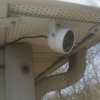- Mar 3, 2018
- 10
- 0
Hi all, I just finished running wires for 2 IPC-HDW5231RP-Z's, and I'm ready to mount the cameras. They'll be going on either side of my garage in the aluminum soffits.
I'm trying to figure out the best way to mount my Jbox's though. I've looked at various modifications of a ceiling fan spanner, but they don't work ideally at all. My other idea is to toenail a piece of 2x6 in between the two rafters and mount the box to it.
I'm just wondering if there are better suggestions? Also, is it better to mount the Jbox inside the soffit and the camera outside, or to mount it in such a way that both jbox and camera are exterior to the soffit? I'm assuming that's a purely aesthetic decision, but figured I'd ask anyway.
Any help? Thanks in advance.
I'm trying to figure out the best way to mount my Jbox's though. I've looked at various modifications of a ceiling fan spanner, but they don't work ideally at all. My other idea is to toenail a piece of 2x6 in between the two rafters and mount the box to it.
I'm just wondering if there are better suggestions? Also, is it better to mount the Jbox inside the soffit and the camera outside, or to mount it in such a way that both jbox and camera are exterior to the soffit? I'm assuming that's a purely aesthetic decision, but figured I'd ask anyway.
Any help? Thanks in advance.



